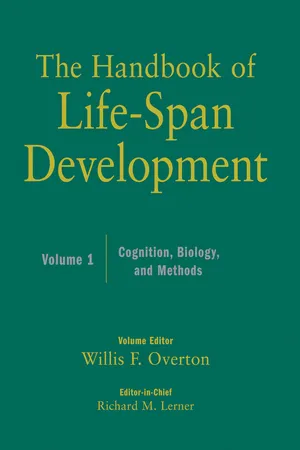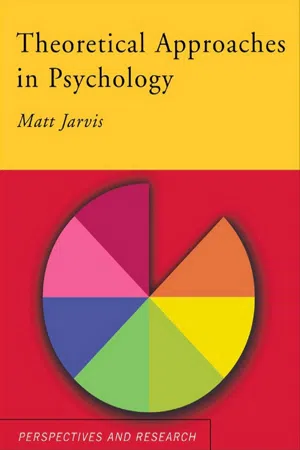Psychology
Biopsychology
Biopsychology, also known as behavioral neuroscience, is the study of how biological processes influence behavior and mental processes. It explores the relationship between the brain, nervous system, and behavior, examining topics such as genetics, hormones, and brain structure and function. By understanding the biological underpinnings of behavior, biopsychologists contribute to our understanding of psychological phenomena.
Written by Perlego with AI-assistance
Related key terms
7 Key excerpts on "Biopsychology"
- eBook - ePub
- G Neil Martin(Author)
- 2015(Publication Date)
- Routledge(Publisher)
Table 1.1 suggests, biological psychologists specialise in the topics that are of interest to them. There are some terms used to describe specific types of biological psychology (and, therefore, biological psychologist) and there are other terms that are synonymous with it. Some of the terms that are interchangeable with biological psychology include psychobiology and physiological psychology – to all intents and purposes, all of these terms refer to the same discipline. Other terms that refer to specific areas of biological psychology include neuroscience, neuropsychology, histology and psychoneuroimmunology.Neuroscience
Neuroscience is an area of study where psychology, physics, chemistry and biology converge. It refers to the study of the neural basis of behaviour, and much of the work in the area is cellular in nature. Neuroscientists are interested in how specific brain cells, types of brain cell or groups of brain cells contribute to brain function and to behaviour. For example, neuroscientists may be interested in discovering whether specific types of cell are involved in specific behaviours (such as object or face recognition); they might be interested in discovering which chemical systems in the brain become active or inactive during certain psychological states such as sleep, mental impairment, depression, schizophrenia, and so on. It is sometimes prefaced by 'cognitive' to indicate that the study involves the neural basis of aspects of cognition such as using language, recognising objects, places and faces, recognising and experiencing emotion, performing mental arithmetic tasks, engaging in visual imagery, and so on (Posner and DiGirolamo, 2000).Some psychologists combine what seem on the surface to be entirely different branches of the discipline, such as neuroscience and social psychology. Social cognitive neuroscience, for example, involves the study of the social processes that influence behaviour, the information processing that gives rise to social behaviour and the neural basis of the cognitive behaviour that involves information processing (Ochsner and Lieberman, 2001). Some of the topics that interest social cognitive psychologists include the role of specific brain regions in socio-emotional behaviour, and the role of neural mechanisms in regulating aggression, dominance and bonding. - Nancy Fenton, Jessica Flitter(Authors)
- 2015(Publication Date)
- Research & Education Association(Publisher)
Chapter 5 Biological Bases of BehaviorBiological psychology can be traced to the beginnings of psychology because it has its roots in physiology. The field of biological psychology , also called neuroscience , focuses on how genes, the nervous system, and the endocrine system influence behaviors and mental processes. Technological advances have allowed biological psychologists to provide a more complete understanding of what occurs on a physiological level during a psychological experience such as thinking or memory.Heredity, Environment, and EvolutionAn important aspect of the study of psychology is the interplay among genetic, environmental, and evolutionary influences. Complex human traits, such as intelligence, aggression, altruism, and personality, are influenced by all of these factors. For instance, psychologists attempt to determine how an individual’s level of aggression is impacted by inheritance and exposure to violence, as well as why aggressive tendencies were naturally selected.Biologists and psychologists are both interested in the various influences of nature and nurture on human traits. Biologists study physical traits, such as height and eye color, or susceptibility to diseases, such as cancer. In contrast, psychologists are interested in behavioral traits and psychological illnesses. Behavioral traits include aggression, intelligence, personality, etc.; psychological illnesses include anxiety, schizophrenia, depression, etc. The scientific discipline of behavioral genetics attempts to integrate the influences of heredity, environment, and evolution in terms of their effect on human behavior.HeredityBiological psychologists are interested in the study of heredity, or how the traits of parents are transmitted biologically to offspring. The nucleus of each human cell contains forty-six chromosomes , twenty-three donated by each parent. Chromosomes that determine gender are known as the X and Y chromosomes . One X chromosome is donated by the mother, and either an X or Y chromosome is donated by the father. An XX individual is female; an XY person is male. Each chromosome contains genes , which are made up of a chainlike molecule called deoxyribonucleic acid (DNA) . Each individual gene can be either dominant or recessive. A dominant gene takes precedence over a recessive gene for that particular trait. For the gene that determines eye color in humans, brown is the dominant gene and blue is the recessive gene. If either parent donates a dominant gene for eye color, the child will have brown eyes. If both parents donate recessive genes for eye color, the child will have blue eyes. A Punnett square can be used to predict the outcome of various traits. The genotype is the genetic makeup for a trait in an individual, which may or may not be expressed, while the observable characteristics of genes are referred to as the phenotype- eBook - ePub
- B.D. Hames(Author)
- 2020(Publication Date)
- Taylor & Francis(Publisher)
In its broadest sense, this can be the examination of the evolution of human behavior, in a field known as evolutionary psychology. Principles from studies of the adaptive functions of structures and behaviors in other species are extended to try to explain human behavior. The approach to social behavior that this leads to is known as sociobiology. This applies Darwinian principles of evolution to the study of social, and particularly reproductive, behavior. A key concept is the selfish gene. In this view, all animal behavior is interpreted as having the goal of increasing the proportion of the individual’s genes in the next generation. The direct comparison of human behavior with that of other species is known as comparative psychology. Usually, it is assumed that the underlying processes examined in other species are the same as, or similar to, those in humans, and this itself implies evolutionary continuity. Physiological psychology is the study of the physiological mechanisms, especially those of the nervous and endocrine systems, underlying behavior and mental processes. Since much of our information about physiological mechanisms comes from studies of laboratory animals, physiological psychology assumes similarity of mechanisms, and evolutionary continuity. Neuropsychology is the study of the neural mechanisms, especially in the cerebral cortex, that underlie psychological, particularly cognitive, processes (see Topic A4). The aim of biological psychology is to explain human mental processes and behavior in biological terms, either evolutionary or physiological. The practice of explaining complex events in terms of simpler ones is known as reductionism. While many biological psychologists do not concern themselves with other approaches to psychology, a fuller picture will come from a broader view - eBook - ePub
- (Author)
- 2012(Publication Date)
- Wiley(Publisher)
Chapter 3 Biological Psychology Robert E. Clark, Jena B. Hales, Stuart M. Zola, and Richard F. Thompson The Mind The Brain Sensory Processes Learning and Memory Motivation and Emotion Cognitive Neuroscience Conclusion ReferencesThe great questions of philosophy, the mind–body problem and the nature of knowledge, were also the questions that drove early developments in the pathways to modern psychology. This is especially true of biological or physiological psychology. Wilhelm Wundt, who founded experimental psychology, titled his major work Foundations of Physiological Psychology (1874/1908). William James, the other major figure in the development of modern psychology, devoted a third of his influential text Principles of Psychology (1890) to the brain and nervous system. Both Wundt and James studied medicine and philosophy, and both considered themselves physiologists. Their goal was not to reduce psychology to physiology but rather to apply the scientific methods of physiology to the study of the mind. The other driving force in early biological psychology was the study of the brain and nervous system.The major topics in modern biological psychology are sensory processes, learning and memory, motivation and emotion, and, most recently, cognition—in short, behavioral and cognitive neuroscience. A number of other areas began as part of physiological psychology and have spun off to become fields in their own right. We treat the major topics in biological psychology separately in the text that follows. But first we sketch very briefly the recent philosophical and physiological roots.The Mind
The history of such issues as the mind–body problem and epistemology is properly the domain of philosophy, treated extensively in many volumes and well beyond the scope of this chapter and the expertise of these authors. Our focus in this brief section is on the history of the scientific study of the mind, which really began in the 19th century. - eBook - ePub
The Handbook of Life-Span Development, Volume 1
Cognition, Biology, and Methods
- Richard M. Lerner, Willis F. Overton, Richard M. Lerner, Willis F. Overton(Authors)
- 2010(Publication Date)
- Wiley(Publisher)
155). The most mainstream of psychology journals, The American Psychologist, often includes articles that promote the reductionist biological nature of behavior. For example, Heinrichs (1993) claims, “Schizophrenia is a kind of brain disease that should be approached as a problem in neuroscience. There are no viable alternatives” (p. 221). Even one of the editors of a major behaviorist journal, the Journal of the Experimental Analysis of Behavior, has argued that psychology is a biological science: “Behavior is a biological property of organisms—what else could it be?” (J. Maar, personal communication, June 7, 2006). And, of course, the general public is led to believe this as well: In the 1950s, the common view was that humans begin as nearly blank slates and that behavior is learned through stimulus and response. Over the ages, thinkers have argued that humans are divided between passion and reason, or between the angelic and the demonic. But now the prevailing view is that brain patterns were established during the millenniums when humans were hunters and gatherers, and we live with the consequences. Now, it is generally believed, our behavior is powerfully influenced by genes and hormones. Our temperaments are shaped by whether we happened to be born with the right mix of chemicals. (Brooks, 2006, p. 14) The alternative view is summed up nicely by Bennett and Hacker (2003): Such assertions as these—namely, that human beings are machines, or that the behaviour of a human being is no more than the behaviour of their nerve cells, or that decisions are taken in and (apparently) by the brain—are not science but metaphysics…Could neuroscience explain why birthdays are celebrated, why Tosca is worth going to, and why a husband might think it appropriate to get tickets to the opera for his wife’s birthday treat? (pp - eBook - ePub
Understanding Abnormal Psychology
Clinical and Biological Perspectives
- Pamilla Ramsden(Author)
- 2013(Publication Date)
- SAGE Publications Ltd(Publisher)
Rosemary Kennedy was the sister of the American President John F. Kennedy and the third child out of nine born to Joseph P. Kennedy Sr. and Rose Fitzgerald. There are many different accounts of the level of Rosemary’s mental disability but all of them document that she was compromised in some way. Whatever her difficulty may have been she was able to function adequately as she had an active social life and attended school. She kept a diary that records various outings, going to the opera, social events, parties and lunches. As a young child she was reported to be placid and easygoing but as she became an adolescent and young adult she was subject to violent mood swings and the family often had difficulty controlling her behaviour. In 1941, when Rosemary was 23, her father was told of a ‘cure’ which turned out to be the prefrontal lobotomy. Without consulting the rest of the family he took her to the two most famous individuals who were performing the procedure all over the United States: Walter Freeman and James Watts. The pair discussed the surgery and told Mr Kennedy that the procedure would help to calm Rosemary’s mood swings. Believing that his daughter would be cured, he agreed. During the surgery Rosemary had a mild tranquillizer but was awake, and Dr Freeman asked her to recite the Lord’s prayer or sing ‘God Bless America’ or count backwards so that he could estimate how far to cut based on her verbal responses. When she became incoherent he stopped the procedure. Rather than being a cure Rosemary was reduced to an infantile mentality that left her incontinent and staring blankly at walls for hours. Her verbal skills were reduced to an unintelligible babble and she required constant care. She was kept at the Kennedy home for a period of time but was moved eight years later to an institution for the mentally handicapped where she remained until her death in 2005.PSYCHOBIOLOGY
Psychobiology refers to the influence of psychological events upon biological functioning. The interaction between the two is continuous and they should never be viewed as being independent from one another. In combination with personality factors, environmental factors and social factors, all of these elements interact and form the basis for individual behaviour both normal and abnormal. This chapter will describe and discuss the various brain structures as well as what can take place when these structures do not function properly. Abnormal behaviour is a product of biology, psychology and environmental interaction and it is often difficult to delineate the specific contribution that all three provide. Where possible, examples will be given, but most of these involve medical conditions rather than exclusively psychological factors. However, it is important in the understanding of abnormal psychology as well as an appreciation that medical conditions generally have psychological interactions. For example, cancer is a strictly medical condition, but the disease process influences the cognitions and psychological processes of the individual. It is not unusual for a cancer sufferer to experience extreme anxiety and depressive conditions concerning their condition and the possibility of their demise.The nervous system
The nervous system controls every move we make and every bit of awareness we experience throughout our lives. It is in control of our mental faculties, psychological interpretations of our environment and biological functioning, and maintains our automatic physiological processes such as breathing and digestion. The nervous system is a means of communication between the body, the brain and the outside world. The nervous system utilizes the bodily senses to collect information that is processed and assimilated and then integrated into memory and response. An intact and properly functioning nervous system allows us to perceive events, incorporate them with previous experiences and other incoming sensations, and then process and integrate the various elements into one complete experience (Bear, Connors & Paradiso, 2006). When a structure or chemical does not work properly as in the case of injury or disease or if the nervous system is genetically flawed, an individual will exhibit abnormal behaviour. - eBook - ePub
- Matt Jarvis(Author)
- 2005(Publication Date)
- Routledge(Publisher)
If you have studied biology, you may by now be asking some very reasonable questions about the relationship between biology and psychology. Surely there must be biological influences on psychology, yet rather surprisingly it is quite possible to read most of a psychology textbook like this without a mention of the humble brain. Regardless of other factors, all thinking, feeling and behaviour is ultimately dependent on the brain and the rest of the nervous system. In this chapter we shall look very briefly at the structure and function of the brain, and at some of the techniques we use to study it. We can then look in depth at bodily rhythms, sleep and dreams, and examine a key application of this field—understanding the effects of shiftwork and jet lag. We can then have a look at a contemporary issue in psychology: whether differences in the abilities and characteristics of men and women can be explained by biological differences. First, however, let us look at the assumptions that underlie the neurophysiological approach to psychology:- Like other biological approaches to psychology, neurophysiology is a science. It uses advanced technology to monitor what is happening in the brain, the rest of the nervous system and other body systems and link these to psychological function.
- Whereas behavioural psychology is most concerned with observable behaviour, psychodynamic psychology with emotion and cognitive psychology with thinking, neurophysiology is concerned primarily with physiological activity. This can include activation of a particular area of the brain, a change in hormone levels, or a change in the brain’s electrical output.
- Neurophysiology emphasises the importance of physiological processes in affecting behaviour, thinking and feelings. Thus a physiological approach to depression would emphasise the importance of alterations to levels of chemicals like serotonin in the brain which are typical of depression.
The brain
Although in some ways the brain is still a mystery to psychologists, we do now have some knowledge about the brain’s structure and functioning. A fuller account of the working of the nervous system and the ways in which this impacts on human behaviour can be found in John Stirling’s Cortical Functions and Kevin Silber’s The Physiological Basis of Behaviour: Neural and Hormonal Processes (both in this series). For now, though, we can have a brief look at the structure and function of the brain.Looking at Figure 9.1 we can pick out a few of the major parts of the brain and examine what we know of their functions. The fact that different parts of the brain are involved in particular functions is known as functional localisation.
Learn about this page
Index pages curate the most relevant extracts from our library of academic textbooks. They’ve been created using an in-house natural language model (NLM), each adding context and meaning to key research topics.






